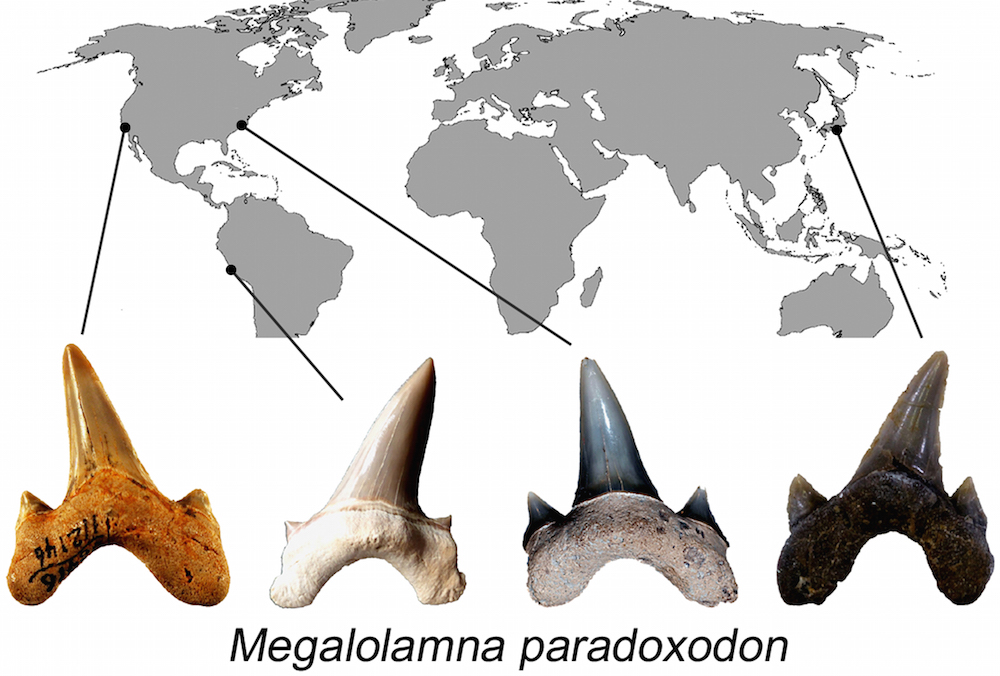Extinct 12-Foot-Long Shark Is Related to Ginormous Megalodon

About 20 million years ago, a car-size shark swam along the ancient coastlines of the Atlantic and Pacific oceans, hunting for medium-size fish with its pointy teeth, a new study finds.
However, there are few fossil remains of the now-extinct shark. Researchers have found merely five of its nearly 2-inch-long (4.5 centimeters) teeth, in different parts of the world: Japan, California, Peru and North Carolina, the researchers said.
"The fact that such a large …shark with such a wide geographic distribution had evaded recognition until now indicates just how little we still know about the Earth's ancient marine ecosystem," said Kenshu Shimada, the lead author of the study and a paleobiologist at DePaul University in Chicago. [Image Gallery: Ancient Monsters of the Sea]
Forbidding teeth
Researchers named the shark, which lived in the early Miocene epoch, Megalolamna paradoxodon. The genus name is a nod to the shark's mega-size teeth that superficially resemble those of sharks in the genus Lamna. The species name notes the shark's strange teeth, with the Latin word "paradoxum," and the Greek "odon," meaning paradox and teeth, respectively.
"At first glance, teeth of Megalolamna paradoxodon look like gigantic teeth of the genus Lamna, that includes the modern porbeagle and salmon sharks," Shimada told Live Science in an email. "However, the fossil teeth are too robust for Lamna — it shows a mosaic of dental features reminiscent of the genus Otodus. So, we determined it to be a species new to science that belongs to the family Otodontidae with no direct relationship with Lamna."
M. paradoxodon's front teeth were fit for grasping, and its back teeth were adept at cutting; these two types of teeth probably helped the giant predator seize and slice prey, Shimada added.
The shark likely lived in shallow, coastal waters in the mid-latitudes, which is where researchers unearthed its fossilized teeth. But even though the researchers have only its teeth, they were able to estimate the length of the shark by comparing the specimens to modern shark teeth.
Get the world’s most fascinating discoveries delivered straight to your inbox.
By analyzing the tooth-to-body ratio of the shark's modern relatives in the lamniform family — including the sand tiger shark, mako shark and great white shark — the researchers estimated that M. paradoxodon could grow to be up to 12 feet (3.7 meters) long. That makes it smaller than the great white shark, which can reach lengths of between 15 and 20 feet (4.6 to 6.1 m).
However, it's hard to say exactly how large M. paradoxodon grew, said John-Paul Hodnett, a shark specialist and graduate student of biology at Saint Joseph's University in Philadelphia who was not involved in the study.
"For teeth, you should always be cautious of the fact that it is possible to have very large or small teeth in a shark's jaw, which do not represent the true aspect of the shark's body size," Hodnett told Live Science. For instance, some of the modern whale shark's teeth are tiny, but the beast can grow to be more than 40 feet (12 m) long, he said.
Megalodon cousin
The prehistoric teeth helped the researchers make another "mega" discovery. They compared them with the teeth of Carcharocles megalodon, an extinct species that is the most massive shark ever known to have lived. Megalodon could grow to be up to 60 feet (18 m) long, and its bite was more powerful than Tyrannosaurus rex's.
Both M. paradoxodon and C. megalodon belong to the extinct family of sharks known as Otodontidae, but scientists previously placed C. megalodon in a distinct lineage, Shimada said.
But Shimada and his colleagues now suggest that M. paradoxodon and C. megalodon are actually close cousins, and that C. megalodon should be should be placed in another genus called Otodus. [7 Shark Mysteries]
"Carcharocles megalodon has been the typical expression for the fossil shark," Shimada said. "However, our new study clearly supports the idea suggested by a few previous workers that 'megalodon' should be placed within the genus Otodus, and thus it should be referred to as Otodus megalodon from now on."
The study was published online Oct. 3 in the journal Historical Biology.
Original article on Live Science.

Laura is the managing editor at Live Science. She also runs the archaeology section and the Life's Little Mysteries series. Her work has appeared in The New York Times, Scholastic, Popular Science and Spectrum, a site on autism research. She has won multiple awards from the Society of Professional Journalists and the Washington Newspaper Publishers Association for her reporting at a weekly newspaper near Seattle. Laura holds a bachelor's degree in English literature and psychology from Washington University in St. Louis and a master's degree in science writing from NYU.



